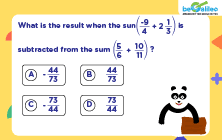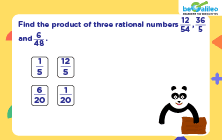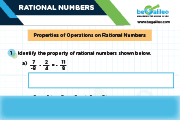Table of contents
Rational numbers is a foundational concept in the realm of mathematics. The term "rational" is derived from "ratio," underlining its connection with fractions that represent ratios. Let us explore the world of rational numbers.
What are Rational Numbers?
Rational numbers are numbers expressed in the form <span class=\"math-feild\">\ rac{p}{q}</span> where p and q are integers and p eq q. They encompass various types of numbers , such as natural numbers, whole numbers, integers, fractions of integers, and decimals. They are integral to our mathematical world, as most of the numbers we encounter daily fall under this category. Every integer, whole number, natural number, and fraction is a rational number, though the reverse is not always true.

Difference between Rational Numbers and Fractions
Fractions have only whole numbers as their numerator and denominator (with the denominator 0). Whereas, Rational Numbers can have integers for both numerator and denominator.
Symbol for Rational Numbers
The collection of rational numbers is symbolized as Q. It'simportant to recognize that rational numbers encompass natural numbers, whole numbers, integers, and decimals.

Examples of Rational Numbers
A glimpse into the world of rational numbers:
- 46: Expressible as .
Every natural number can be written as a rational number with denominator as 1 - -3: Expressed as .
Every integer can be written as a fraction with 1 as the denominator. - 0: Can be denoted as
0 can be written as a fraction with a non-zero denominator. - =2: Square roots of perfect squares are rational.
- :Negative fractions are rational.
- 0.2 or:Both decimal and fractional formats are rational.
- : Rational fractions, simplifiable.
Examples of Numbers which are not Rational Numbers
Certain numbers don't adhere to rationality. Take the case of square roots, cube roots, etc., of natural numbers, where exact values elude us. Such numbers are not rational numbers. Examples: , , , : etc.
Types of Rational Numbers
Rational numbers come in several forms. The different types of rational numbers are given below:
- Integers: -2, 0, and 5.
- Fractions: e.g., .
- Terminating Decimals: Such as 0.35, 0.667.
- Non-terminating Decimals with Repetitive Patterns: e.g., 0.222…, 0.141414…

Rational and Irrational Numbers
Numbers that aren't rational are irrational, such as , π (pi) are called Irrational numbers.. Rational numbers include terminating and non-repeating decimals, while irrationals lack repeating patterns or accurate values. Do note that the sum of rational and irrational numbers is irrational.
Difference between Rational and Irrational Numbers
The key differences between rational and irrational numbers are listed in the table below.
| Rational Numbers | Irrational numbers | Irrational numbers |
|---|---|---|
| Expressible as Ratio | Yes | No |
| Nature of Decimal | Finite / Recurring | Non-terminating / Non-repeating |
| Form as fraction | Yes | No |
| Examples | 4, 9,<span class=\"math-feild\">\sqrt{25}</span> | <span class=\"math-feild\">\sqrt{2}\sqrt{3}</span> |
Operations with Rational Numbers
Manipulating rational numbers via arithmetic operations is a fundamental skill in mathematics. Understanding these operations—addition, subtraction, multiplication, and division—enables you to solve a variety of sums and scenarios.
Addition of Rational Numbers
Addition allows us to merge rational numbers, just as we combine quantities in real life. These are the 2 rules for addition of rational numbers
- 1.
When the denominators of the given rational numbers are equal, we add the numerators and keep the denominators the same.
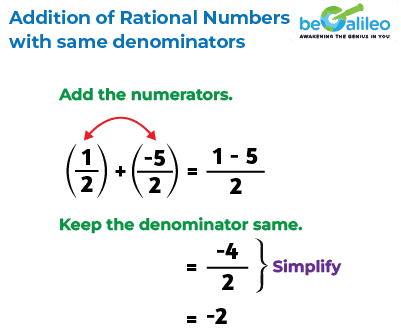
- 2.
When the denominators of the given rational numbers are different, we first make them equal by finding the equivalent rational number using the concept of LCM (least common multiple). Once, the denominators are equal, we add the numerators and retain the denominator.

Subtraction of Rational Numbers
Subtraction helps us to find the difference between rational numbers. Similar to addition, rational numbers must share a common denominator for accurate subtraction. The rules for subtraction of rational numbers are similar to addition.
- 1.
When the denominators of the given rational numbers are equal, we subtract the numerators and keep the denominators the same.
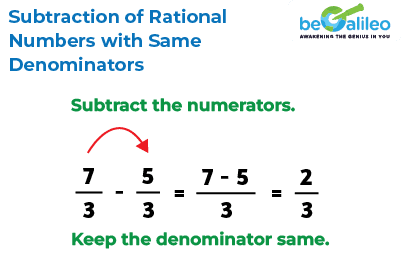
- 2.
When the denominators of the rational numbers are not the same, we start by making them equal. This is done by finding equivalent fractions using the LCM (least common multiple). Once the denominators are the same, we can then subtract the numerators while keeping the denominator unchanged.


Multiplication of Rational Numbers
Multiplication is the easiest of the four arithmetic operations. To multiply two rational numbers, you multiply the numerator of the first number by the numerator of the second number, and you also multiply the denominator of the first number by the denominator of the second number.
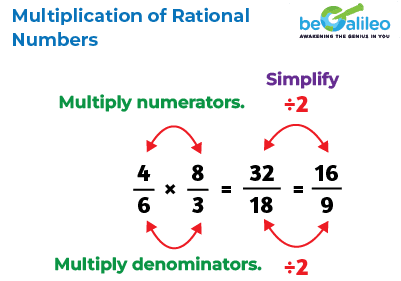
Division of Rational Numbers
Division helps us in sharing quantities fairly among rational numbers. We know that the number which is to be divided is called the dividend and the number by which it is divided is called the divisor. To divide a rational number by another rational number, we multiply the first rational number (dividend) by the reciprocal of the second rational number (divisor).

Fun Fact: Infinite Surprises of Non-Terminating Decimals
Ever wondered about numbers that never seem to settle down? Non-terminating decimals, like 0.333... or 0.141414..., keep going forever without repeating the exact same sequence. What's intriguing is that these seemingly endless patterns can actually be tamed into rational numbers. For example, 0.333... can be expressed as , revealing the magic behind the numbers' infinite dance. It's like catching a glimpse of the endless possibilities hidden within the mathematical universe!
Solved Examples
Q1. Use the diagram to select the correct answer. Which of the following is a rational number as well as an integer?
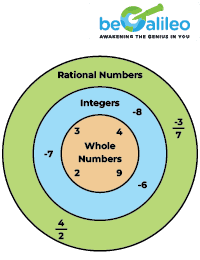
- a)
- b)
- c)
- d)
Solution: The correct answer is b)
All integers are rational numbers but not all rational numbers are integers. We can say, , ,and , are not integers as we cannot simplify the numerator and the denominator.
= 2. Hence rational number as well as an integer.
Q2. Choose True or False. 1 lies between and .
- a) True
- b) false
Solution: The correct answer is a) True.
We know
and
So,
Hence, the given statement is correct.
Q3. Find the sum of two rational numbers and.
- a)
- b)
- c)
- d)
Solution: The correct answer is c) 1
Since the denominators are not the same, we need to take L.C.M in order to convert the denominators the same. L.C.M (4, 3) = 12
Q4. The number line shows an unknown number r. Is positive or negative?

Solution: From the number line, we can see that r is negative. Hence (-r) is positive.
is positive.
Therefore, is also positive.
Q5. The product of two rational numbers is . If one of them is . Which of these is the other number?
- a)
- b)
- c)
- d)
Solution: The correct answer is c)
Let one of the rational numbers be a.
It is given that,
By the property of reciprocals,we get
Hence, option (d) is correct.
Practice Problems
1. Choose the correct option for the numbers 0.5444.... and 0.453.
0.453 is not a rational number
Only 0.5444.... is a rational number
Both are not rational numbers
Both are rational numbers
2. Choose the correct statement for the numbers .
Onlyis a fraction
Both are fractions
Onlyis a fraction
Onlyis a rational number
3. What will be the result when a rational number is multiplied with its reciprocal?
-1
1
0
the number itself
4. If , q= , and r= .Find the value of .
5. Choose a number that is not a rational number.
-200
Frequently Asked Questions
What age group is beGalileo designed for?
Can I try beGalileo before committing to a package?
What is the difference between self-paced and live class options in beGalileo?
How can beGalileo support homeschooling parents?
What curriculum does beGalileo follow?
How can I track my child's progress?
What is the frequency and duration of beGalileo tutoring classes?
Can beGalileo's program be customized for my child's specific learning requirements?
Can your teachers teach topics covered in my child's school curriculum?
Can my child join beGalileo anytime during the year?
What if I am not satisfied with beGalileo's classes after enrolling?
How do I enroll for beGalileo's classes?



